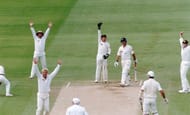Whenever a low-scoring match that goes to the last ball of the game is followed by a high scoring affair by the same teams in the next game, it creates an immense amount of buzz in social media. There are plenty of reasons as to why a team that scored 140 in 20 overs can also score 200 the very next game. A very crucial factor that affects the scoreboard is the pitch on the match day.
Apart from the three types of pitches mentioned below, other factors like the wicket being too soft, dry or hard can affect the game and overall score of the match. If the wicket is too dry the then it might have many small cracks that lead to uneven bounce and turn to make it dangerous for the batsmen. On the other hand, a soft pitch can make the wicket extremely slow for the batsmen to score and the ball may move and seem sticky on the pitch.
However, there are three basic types of pitches one generally comes across at the international level of cricket:
#1 Dead Pitch
A dead pitch is entirely flat with absolutely no grass or moisture on the surface. The continuous rolling on these pitches removes the grass and moisture, and these dark pitches are best suited for batsmen as it doesn't assist the spin or pace bowlers. The subcontinent consists of a majority of the dead pitches, which are especially seen during limited overs matches.
A dead pitch is not the best suit for Test wicket as it makes it extremely challenging for bowlers to take wickets. A high-scoring Test match ordinarily consists of these types of wickets with no grass or moisture. However, this is an ideal pitch for an ODI or T20 match as these wickets have nothing to offer for the bowlers. It assists the batsmen to score plenty of runs on the scoreboard and the games played on these kind of wickets tend to have a high score from both the teams.
#2 Green Pitch

The grass cover on these pitches enables movement for fast bowlers. Green pitches are a dream surface for seam bowlers as they can showcase their swing and pace prowess. However, they can cause a significant threat to the batsmen. These wickets have a grass cover on the good length area causing the ball to move and swing after pitching on the surface.
England, South Africa and Australia have a lot of grounds that boast of such pitches which enables their best bowlers such as Anderson, Steyn or Starc to wreak havoc on the opposition.
Green pitches are ideal for Test matches as they examine the temperament of batsmen against seam and swing bowlers. The grass on the pitch reduces the roughness of the surface that allows the ball to swing regularly thereby testing the batsmen's technique. However, this pitch doesn't accommodate for spinners as the ball doesn't grip the surface.
#3 Dusty Pitch

The primary characteristic of a dusty pitch is that it is soft. A dusty pitch is easily the best wicket for a spinner as pitches are left unrolled, that allows the ball to grip. They are ideal for spinners as the ball tends to grip the surface allowing it to turn a lot more than the other wickets.
However, these pitches have predictable or low bounce making it easy for batsmen to score runs once they adjust themselves to the conditions. Similar to a dead wicket, the subcontinent conditions favour dusty pitches. For these reasons, the Indian cricket team is known to rely on their spinners to obtain wickets in home conditions.
Brand-new app in a brand-new avatar! Download CricRocket for fast cricket scores, rocket flicks, super notifications and much more! 🚀☄️
